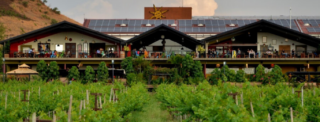- Resources
- India’s largest wine producer is helping its customers sip more sustainably
Resources
India’s largest wine producer is helping its customers sip more sustainably
Published: June 3, 2019 by Yesh Pavlik Slenk
Last year, global wine production rose to near-record highs, reaching a harvest of 292.3 million hectoliters that’s more than 7.7 billion gallons. In the U.S. alone, domestic and imported wine sales reached $70.5 billion. The world clearly loves wine.
But, few industries feel the perils of climate change more directly than the wine industry. And with temperatures expected to only become more extreme, wineries are being forced to consider the long-term risk a changing climate will have on their business.
I had a chance to chat with Inesh Singh, the first-ever Chief Sustainability Officer of Sula Vineyards, India’s largest wine producer. For Inesh, sustainability isn’t just an opportunity to save the company money, it’s a key part of its long-term survival. Inesh is GreenBiz’s 30 Under 30 honoree, and was an EDF Climate Corps fellow with PepsiCo back in 2016.
Here’s an edited version of our conversation.
How are businesses thinking about sustainability in India?
India is a developing country and because of that most businesses are focused on short-term growth. As a result, there is less of a push to use sustainability as a driver for a successful business, and it’s created an environment where climate-related challenges are not prioritized.
If you look at the U.S., there are many brands whose unique selling proposition is being sustainable, and they’ve secured a customer base that is willing to pay a premium for their products. That’s not so much the case in India, and because of that – this lack of success stories- has slowed the conversation around how businesses can transition to becoming more sustainable.

A positive side effect I’ve come to realize, though, is that a weak regulatory environment can actually serve as a driver for sustainability at times. Consider water in India, the government is often not able to guarantee water security. Since that is a resource our business can’t function without, we are focusing more of our efforts on water conservation practices.
How is sustainability woven into the vineyard’s business strategy?
The direct impact of climate change on our business has put sustainability at the center of our strategy a concept that is fairly unique for India. We’re trying to run our business in a way that not only has a positive environmental impact, but also makes sense from an economic and business perspective.
We are looking for ways to be leaner, because we have to be. We’ve managed to achieve low utility costs and self-provided water security. We’re also starting to embed sustainability into our marketing by communicating our journey to our customers, which is helping them recognize Sula Vineyards as a sustainable brand.
Where are you seeing the biggest impacts of climate change on operations?
Climate change impacts us all across our value chain, especially in three key operational areas: viticulture (the growing of grapes), winemaking and our supply chain or logistics.
The biggest impact is felt in viticulture. Warmer temperatures make the crops mature faster, which impacts development of flavors in a grape, and therefore our product. Changing weather patterns and irregular rainfall also impact our harvest dates, forcing us to be agile in our planning and to be more innovative with our water management. It also leads to increased pest menace and need for more management.
In operations, rising temperatures requires more cooling at our manufacturing site, which increases our utility expenses and our carbon emissions. Higher temperatures also impacts our supply chain, and downstream logistics. Wines must be kept at cool temperatures during transport and storage, as well as before it hits the shelf or enters into a customer’s house. We have a very diverse group of downstream stakeholders, and we’re hoping to partner with them to drive further reductions downstream.
How are you managing growth and sustainability?
Sustainability is a key driver of our growth, and without it, we would have a very hard time growing as a business. It’s a matter of evolving for a changing scenario.
Take water for example. Sites where we originally established our units were historically water rich and now face periods of drought. This requires us to be agile and evolve for this changing scenario. Otherwise, it would have become almost impossible for us to operate, forget driving growth. As a result, we focus a lot on water management, like rainwater harvesting infrastructure, in-house effluent treatment plants and drip irrigation.
Partly why we’ve been successful is because we have agile, dynamic, and adaptable employees who can, at the end of the day, still drive results in challenging environments.
So tell me, what is your favorite of the Sula wines?
My favorite is a wine called “The Source sauvignon blanc”. It has a nice balance between the classical sauvignon blanc and Sula’s unique blend, which takes the taste to the next level.
Follow Yesh on Twitter
Follow EDF+Business on Twitter
